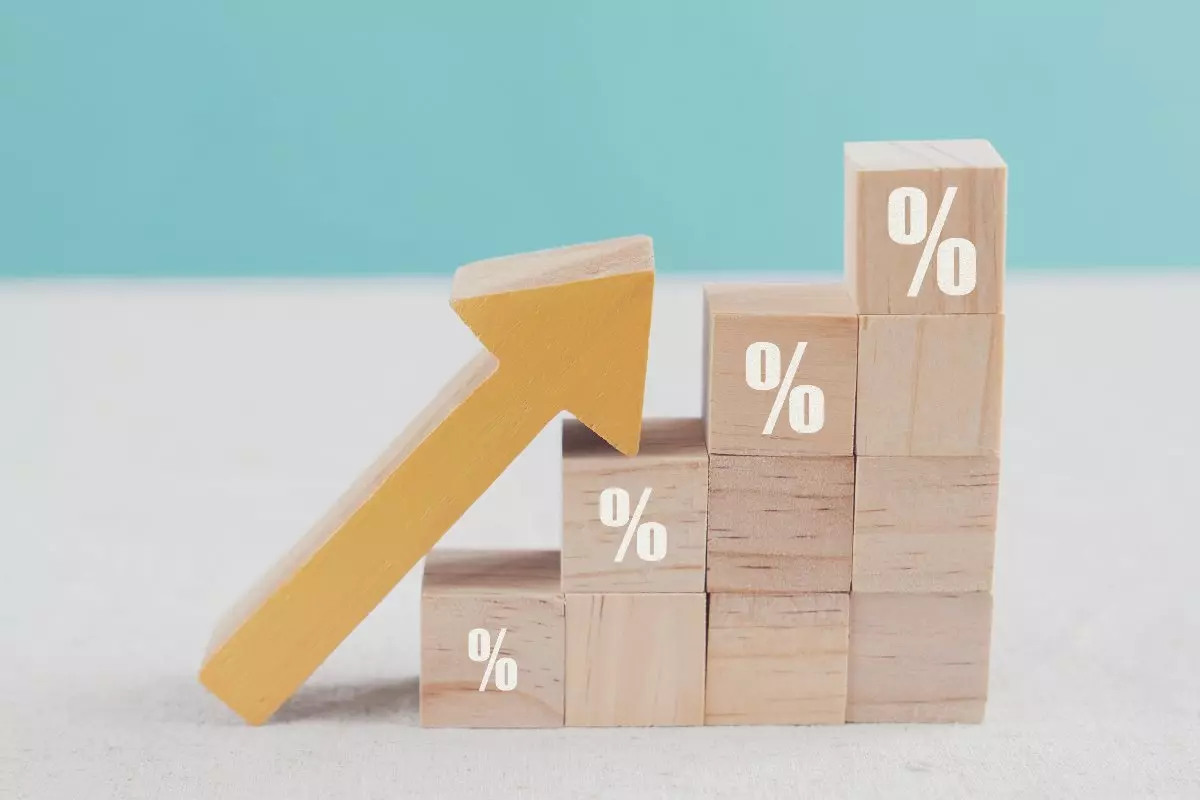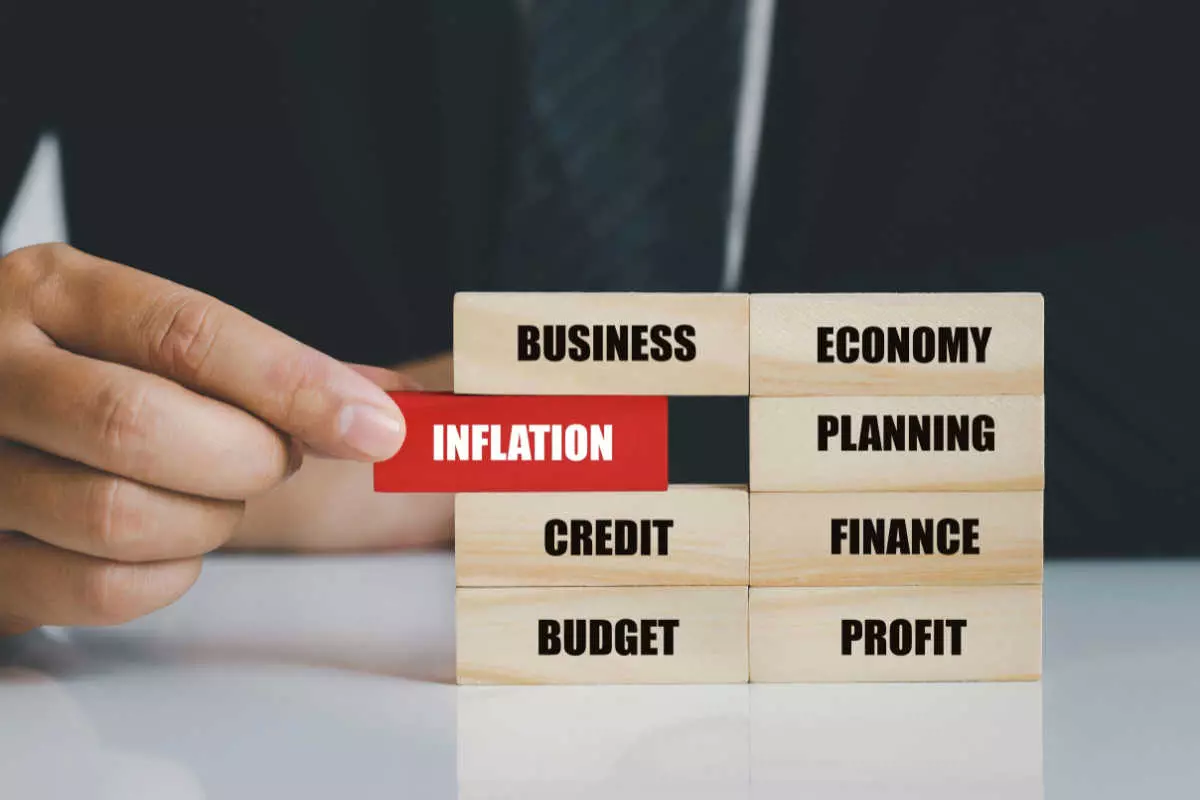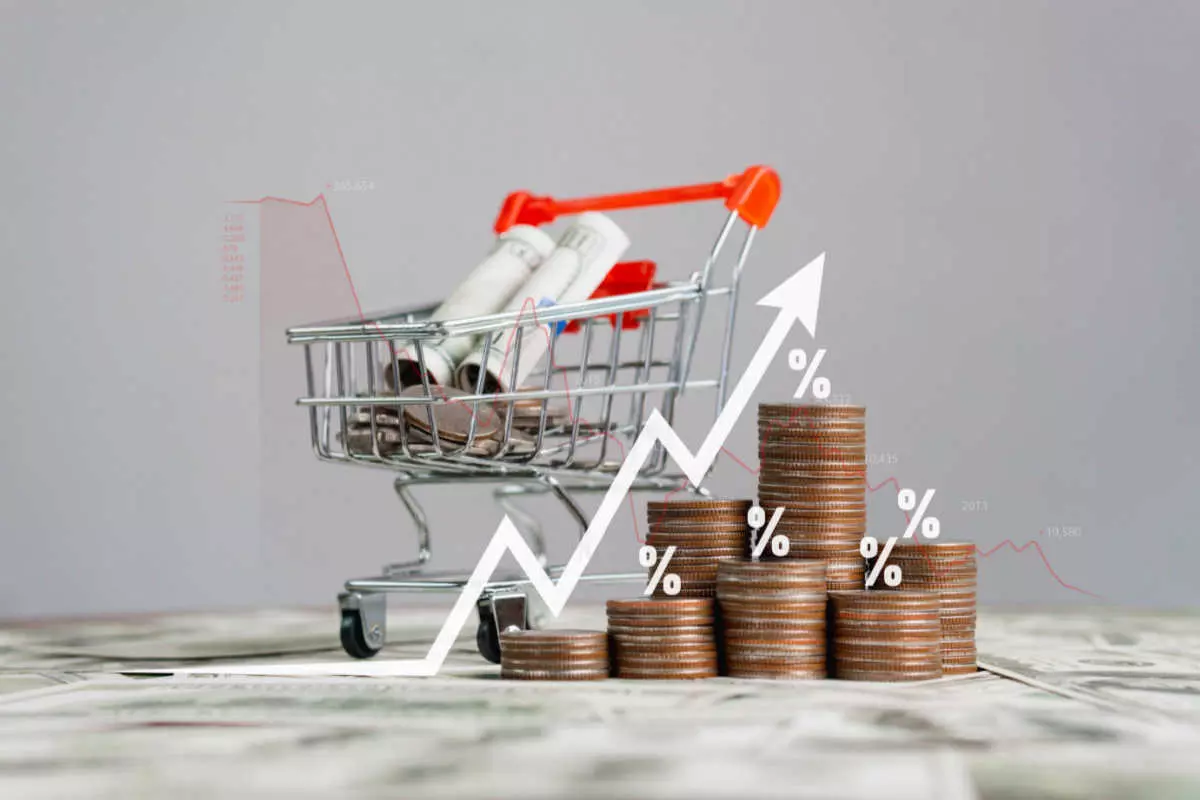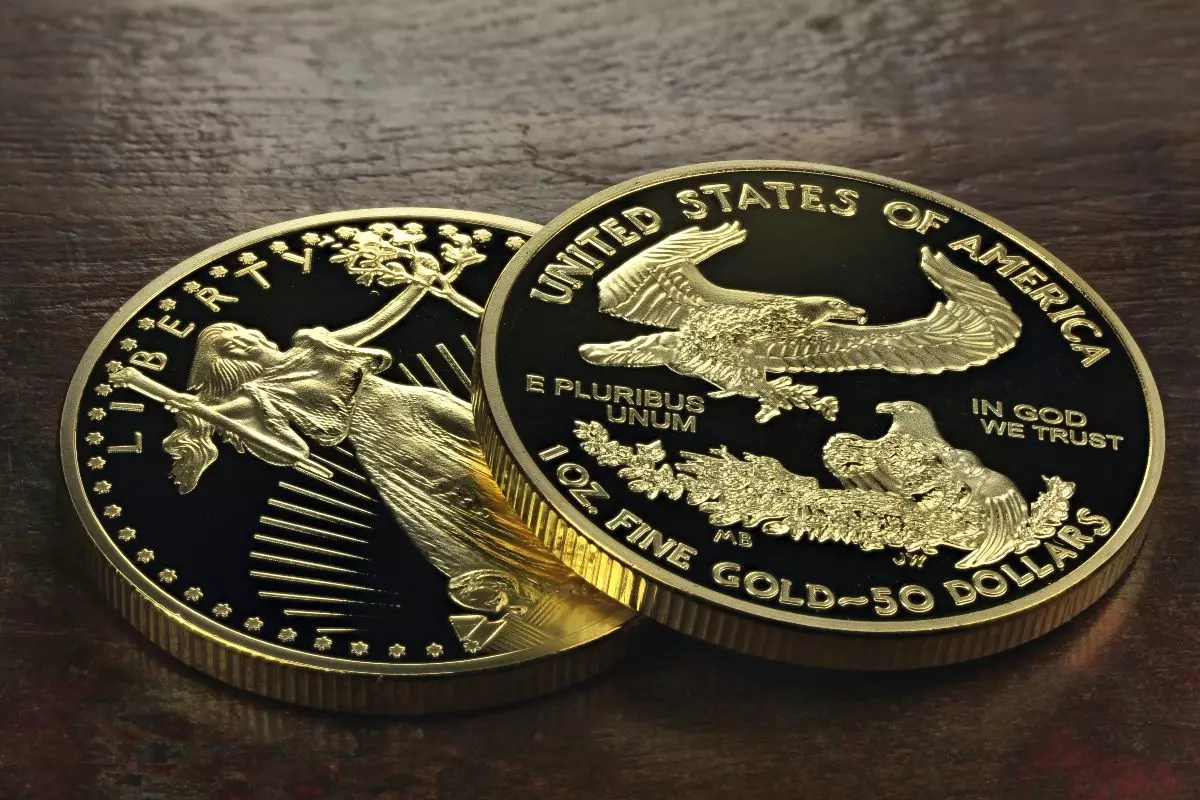Navigating the global economy requires investors to understand pivotal concepts like inflation and stagflation. These forces influence financial markets and your investments in various ways.
As Sam Ewing humorously observed, “Inflation is when you pay fifteen dollars for the ten-dollar haircut you used to get for five dollars when you had hair.”
This witty remark captures the essence of inflation – the erosion of purchasing power due to rising prices.
In this article, we’ll dissect types of inflation and stagflation, examining their causes, effects, and implications for your investment strategies. By the end, you’ll be better equipped to comprehend these economic phenomena and make informed financial decisions. Let’s dive in and unravel the complexities of inflation and stagflation.
What Is Inflation?
Inflation describes an increase in the prices of all goods. The term comes from the Latin word “inflare”. The latter means to “blow up or inflate.” It was initially used in a monetary sense to denote “an increase in the amount of money.”
When looking at inflation, you’ll see the following: inflation refers to the increased rate of prices over a certain period. According to the International Monetary Fund (IMF), inflation is a broad measure showing the overall increase in prices or the rise in living costs in a country.
According to the Department of Labor, inflation represents the overall rise in the price of goods and services in an economy and the dip in purchasing power of a country’s currency, such as the U.S. dollar.

Central banks, economists, and government officials use this measurement tool to gauge whether action is necessary to keep an economy healthy. For example, the U.S. Department of Labor uses more than one index to measure inflation from different aspects, which, together with the types of inflation, will be discussed below.
Most central banks set a low and constant inflation target, which is usually from 1.5% to 4% annually. Specifically, high inflation can result in lower purchasing power. The reason is that prices tend to increase, and those who live on a fixed income end up with decreased buying power.
What’s One of The Inflation Examples?
If the inflation rate is 2%, then a one-dollar product will rise in price to cost $1.02 in the following year. So, with steady inflation at 2%, the economy can be more or less stable, and consumers can continue to comfortably afford the same goods and services.
Thus, by looking at the inflation rate, you can judge the health of a country’s economy. According to Trending Economics, the highest annual inflation rate in the U.S. was 23.7% in 1920.
Causes of Inflation: Factors Contributing to Rising Prices
You can come across inflation in almost any industry, including food, housing, cars, cosmetics, and stocks. These price changes can happen at any time. The price of one commodity can rise and could drop. But what are the causes of inflation? Here are the most common reasons:
Demand-Pull Inflation
Demand-pull inflation occurs when the demand for specific goods and services exceeds the economy’s capacity to meet those requests. When demand exceeds supply, companies raise the prices of their products or services. This is also referred to as “price inflation.”
Let’s take the example of the tickets for a live performance on Broadway. If there’s a limited number of seats and the demand for the live show is much greater than capacity, the ticket prices can skyrocket, reaching up to $2,000 on third-party sites. This is above the standard ticket price of $139 and the premium ticket price of $549.
Cost-Push Inflation
A cost-pull situation is when there is a rise in overall prices because of an increase in wages and raw material costs. It’s also called the “wrong type of inflation.” The reason is that cost-push is linked with falling living standards.
For example, low-paid employees in a factory form a union and demand higher wages. Possibly, the owner will shut down the factory in response. As a result, the manufacturing of the products will decrease, thus leading to higher prices in the market.
Built-in Inflation
Built-in inflation, also called a “wage-price spiral,” happens when prices are increased to keep up with rising wages. For instance, as workers demand higher wages to offset increased living costs, businesses raise prices to maintain a profit. This ultimately leads to a cycle or loop of increased wages and costs of goods.
Demand-Pull and Cost-Push Inflation
Before discussing the types of inflation, let’s answer the question:
How Does Demand-Pull Inflation Differ From Cost-Push Inflation?
The main difference is that cost-push inflation is driven by an increase in the costs of production, whereas demand-pull inflation is driven by increased demand for goods and services.
For instance, cost-push inflation is often seen in the oil industry. Factors such as natural disasters, war, and political uncertainties can affect the supply and price of oil. Nevertheless, the demand for oil remains the same. As a result, the price of oil skyrockets for consumers as exporters try to offset the additional costs they face.

Some think that the pandemic is an example of demand-pull inflation. However, it is not a direct example of demand-pull inflation. The pandemic resulted in a mix of demand and supply-side shocks, leading to inflationary pressures in some sectors and deflationary pressures in others.
Main Types of Inflation
There are different inflation types based on the driving factors. Let’s discuss the types separately.
Core Inflation
Core inflation is the increase in the prices of everything apart from food and energy. The core inflation measurement excludes food and energy prices as they’re volatile.
The change in the core Personal Consumption Expenditures (PCE) Price Index is what the Federal Reserve prefers to measure core inflation in the United States. This index relies on a dynamic consumption basket. PCE will be discussed below under “How Inflation is Measured.”
Disinflation
When the pace of inflation temporarily slows down, this is disinflation. For example, the inflation rate can reduce marginally over the short term. For instance, disinflation can represent a change from 3% one year to 2% the next. If the rate has already significantly fallen, disinflation could result in deflation.
Please note that disinflation is a reduction in the rate of inflation, but this does not necessarily lead to deflation. Disinflation could lead to a slower rate of price increases without causing a decrease in prices.
Deflation
Deflation is the general decrease in the price of goods and services in an economy and shows the growth in the purchasing power of a country’s currency.
Specifically, when the supply of money or credit declines, and there isn’t any corresponding reduction in economic output, the price of goods and services drops. In addition, deflation can emerge when there is a lack of demand or a rise in productivity, such as technological advances reducing the cost of goods and services.
For example, because of the 2009 crisis in China, the country’s economy faced deflation in factory prices. Namely, producer prices were dropping faster. The reasons included lower prices for oil and other commodities, a surplus of factory capacity, and a lack of demand from exporters and Chinese buyers.
Stagflation
The next type is called stagflation. It represents a painful mix of high prices and poor growth. In this case, you deal with economic adversity fueled by poor economic growth, increased unemployment rates, and higher inflation.
The Great Inflation that the United States experienced between 1965 and 1982 is a vivid example of stagflation. During those years, the country faced high inflation and unemployment because of four economic recessions, two energy shortages, and wage and price controls. Today, stagflation may occur as a result of the pandemic.
Hyperinflation
Hyperinflation is also among the types of inflation. It refers to a period of rapid inflation. Specifically, hyperinflation is about 50% or more inflation in a month and doesn’t happen often. However, it can occur during wartime or economic turmoil. As a result, the prices of essential goods, such as food and fuel, surge quickly and exponentially as the items become scarce. During hyperinflation, a country’s currency can be reformed, discarded, or replaced.

For example, during the 1920s, Germany had to pay war reparations set forth by the Treaty of Versailles. The amount of money owed made the country print endless unbacked currency. As a result, the country’s currency became worthless.
To prepare for hyperinflation, individuals may consider investing in assets that hold value during inflationary periods, such as real estate, commodities, and precious metals.
Creeping Inflation
Creeping inflation is also known as mild or moderate inflation. This is when prices increase by 3% or less per year. This type isn’t as harmful as other types of inflation. However, it can negatively impact the economy and result in higher prices for consumers.
As compared, economies can benefit from a 2% or lower price increase, according to the Federal Reserve. Creeping or mild inflation drives demand by making the consumers anticipate a rise in prices.
For example, in the United States, people have seen this type of inflation in growing gas prices, food costs, and higher tuition rates.
Walking Inflation
When there is inflation between 3% to 10% a year, you deal with trotting or walking inflation. It can be devastating for the economy as it forces people to buy more than necessary to avoid further increases in price.
Running Inflation
This type refers to a rapid rise in prices at the rate of 10% to 20% per year. It adversely affects the poor and middle class. The good news is that strong monetary and fiscal measures can improve the situation.
For example, governments pursue a contractionary monetary policy, which means they reduce the money supply within an economy. Specifically, the U.S. Federal Reserve uses contractionary monetary policy by raising interest rates. In addition, governments can put a cap on the prices of specific goods.
Galloping Inflation
Galloping inflation is another type of inflation. In this case, inflation reaches 10% or more. This rate is fraught with serious problems, and it can be challenging to bring the situation under control.
Specifically, money loses its value so quickly that people and businesses cannot keep up with costs and prices. Moreover, foreign investors avoid countries facing this type of inflation. Thus, the economy loses its stability because of all the factors involved.
How to Protect Your Money From Inflation
To stay ahead of inflation and avoid the adverse effects of lost money, you can invest your money in assets that offer potential growth. This is especially important today when the surge in consumer prices makes it increasingly tough to manage the cost of living.
Here are some ways you can protect your money against inflation:
Buy Gold
One of the cushions to fall back on during uncertainty and turmoil is to invest in gold. Gold is often viewed as a hedge against inflation or an “alternative currency.” This is especially true in countries where the native currency is already losing value. As a rule, these countries rely on gold or other strong currencies when faced with falling fiat money.
Gold is a tangible asset that has historically demonstrated stability over the long term. Therefore, if you are considering safeguarding against a potential collapse, you may opt to invest in physical gold coins and bars, or other precious metals as a means of protection.

Since the early 2000s, the average gold price has grown significantly, as Statista reports. In 2019, the annual average gold price witnessed growth to nearly $1,400 per troy ounce. According to a gold demand trends report from the World Gold Council, physical demand for gold grew by 34% year over year (YoY) to 1,234 tons in the first three months of 2022.
Invest in a U.S. Treasury Bonds (T-Bonds) Or Inflation-Linked Savings Bond (I-Bonds)
US Treasury Bonds (T-Bonds) are fixed-income securities that the government issues to generate revenue for federal operations. The government fully backs T-Bonds, meaning they are relatively safe investments, and individuals are guaranteed to receive their principal back in full. They provide long-term investments ranging between 10 and 30 years. When you invest in them, you’ll be paid periodic interest every six months until the account reaches maturity.
Similarly, I-Bonds are also backed by the government with long-term maturity dates. Unlike T-Bonds, the interest rate for I-Bonds fluctuates based on the inflation rate. This is because the interest rates for I-Bonds are based on changes in the consumer price index (CPI). As a result, I-Bonds don’t decrease in value due to inflation.
Invest in Real Estate
The demand for housing hasn’t fluctuated much. As a result, real estate is among the lowest-risk asset classes you could invest in. Consider purchasing a property at a fixed rate and then renting it out. This is a reliable source of income.
Effects of Inflation
Inflation can affect the economy in more than one way. For example, a country’s currency can decline because of inflation and exporters’ goods can become cheaper when priced in foreign currencies. Specifically, money loses its value during inflation, meaning the exporter spends the same amount but earns less. On the other hand, this could also create problems for importers since foreign products can become more expensive.
Higher inflation can also result in increased consumer spending, as they’ll start purchasing products quickly to avoid a further rise in prices. However, this could also mean a limited ability to spend or invest in the future.
How Inflation Is Measured?
The Consumer Price Index (CPI) and the Personal Consumption Expenditures (PCE) Price Index are the two most frequently cited indexes used to calculate the inflation rate in the U.S.
The U.S. Bureau of Labor Statistics (BLS) uses the Consumer Price Index (CPI). The CPI shows the general rate and is probably the most popular gauge of inflation.
The index is based on the information received from a survey of 23,000 businesses. It records the prices of 80,000 consumer items monthly. More specifically, to calculate CPI inflation, the BLS takes the average weighted cost of a goods basket in a given month and divides it by the same basket from the previous month.
Similarly, the Bureau of Economic Analysis (BEA) calculates PCE inflation by considering the price changes of a goods basket. Compared to the CPI, instead of asking consumers how much they spend on specific goods and services, the PCE tracks the prices businesses set for selling goods and services.
According to the data published by the International Monetary Fund, the U.S. Consumer Price Index was nearly 258.84 in 2020 and is projected to reach 319.21 in 2026. Importantly, a rising CPI denotes an increase in prices. So, a higher CPI speaks of higher inflation, and a falling CPI means dropping inflation.
Compared to other regions, the U.S. inflation rate is relatively low. The U.S. April Consumer Price Index report shows that the annual CPI inflation dropped slightly in April 2022, featuring a 12-month figure falling to 8.3% from 8.5% in March.
Final Thoughts
Inflation represents the economic process of prices increasing over time. It can lead to different outcomes, such as higher costs of living, decreased purchasing power, diminished currency value, and economic turmoil.
James Miller is a Senior Content Writer at McGruff.com. He has a background in investing and has spent most of his career in the financial industry. He can trace his family tree back to the California Gold Rush when his ancestors risked it all to make it big in the west. He feels like he's following in their footsteps as he strives to make sense of today's gold market.
